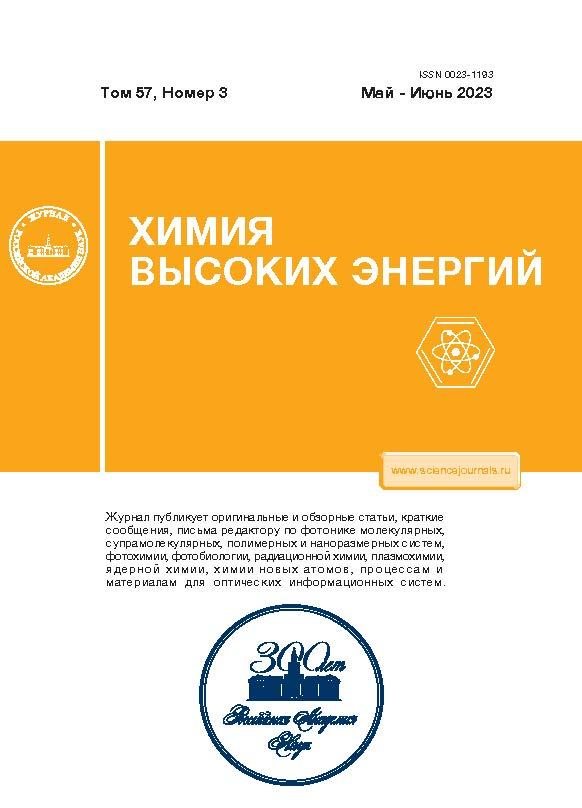Effect of Copper Ions on Quercetin Reactivity in Free Radical Reactions and Radioprotective Activity
- Autores: Lysenko A.G.1, Fenin A.A.1
-
Afiliações:
- Mendeleev University of Chemical Technology
- Edição: Volume 57, Nº 3 (2023)
- Páginas: 198-200
- Seção: RADIATION CHEMISTRY
- URL: https://rjeid.com/0023-1193/article/view/661504
- DOI: https://doi.org/10.31857/S0023119323030087
- EDN: https://elibrary.ru/KDOJBR
- ID: 661504
Citar
Texto integral
Resumo
Steady state radiolysis showed a decrease in the reactivity of quercetin in free radical reactions with the 1-hydroxyethyl radical and the superoxide radical anion as a result of the formation of a complex with a copper ion. The negative effect of copper ions can be reduced via destroying the resulting complex by introducing chelating compounds, such as tartaric acid and EDTA. The nature of the change in reactivity corresponded to the change in the radioprotective activity of quercetin in relation to yeast cells.
Palavras-chave
Sobre autores
A. Lysenko
Mendeleev University of Chemical Technology
Email: fenin.a.a@muctr.ru
Moscow, 125480 Russia
A. Fenin
Mendeleev University of Chemical Technology
Autor responsável pela correspondência
Email: fenin.a.a@muctr.ru
Moscow, 125480 Russia
Bibliografia
- Кудряшов Ю. Б. Радиационная биофизика (ионизирующие излучения) / Под ред. В.К. Мазурика, М.Ф. Ломанова. М.: ФИЗМАТЛИТ, 2004. 448 с.
- Zeng Y., Song J., Zhang M., Wang H., Zhang Y., Suo H.. // Antioxidants (Basel). 2020. V. 9(8). P. 732. PMID; PMCID: PMC7465758.https://doi.org/10.3390/antiox908073232796543
- Raman S.T., Ganeshan A.K., Chen C., Jin C., Li S.H., Chen H.J., Gui Z. // Pharmacogn Mag. 2016. V. 12(46). P. 128–33. PMID; PMCID: PMC4809167.https://doi.org/10.4103/0973-1296.17791027076749
- Terao J. // The J. Medical Investigation: JMI. 1999. V. 46(3–4). P. 159–168. PMID: 10687310
- Procházková D., Boušová I., Wilhelmová N. // Fitoterapia. 2011. T. 82. № 4. C. 513.
- Lekka C.E. et al. // The J. Physical Chemistry B. 2009. T. 113. № 18. C. 6478.
- Костюк В.А. Биорадикалы и биоантиоксиданты / В.А. Костюк, А.И. Потапович. Минск. 2004. С. 10–16; С. 82–98.
- Jomová K., Hudecova L., Lauro P., Simunkova M., Alwasel S.H., Alhazza I.M., Valko M. // Molecules. 2019. V. 24(23). P. 4335. PMID; PMCID: PMC6930463.https://doi.org/10.3390/molecules2423433531783535
- Žuvela P., David J., Yang X., Huang D., Wong M.W. // Int. J. Mol. Sci. 2019. V. 20(9). P. 2328. PMID; PMCID: PMC6539043.https://doi.org/10.3390/ijms2009232831083440
- Simunkova M., Barbierikova Z., Jomova K., Hudecova L., Lauro P., Alwasel S.H., Alhazza I., Rhodes C.J., Valko M. // Int. J. Mol. Sci. 2021. V. 22(4). P. 1619. PMID; PM-CID: PMC7915082.https://doi.org/10.3390/ijms2204161933562744
- Суворова А.А., Фенин А.А. // Радиационная биология. Радиоэкология. 2010. Т. 50. № 2. С. 180.











